I may have mentioned this before, but I love comic books and so does my five-year-old daughter. Our bi-weekly trips to our local comic book store are among my favorite rituals we have. And, almost every time we go, my daughter gets to pick out a comic book for herself. Sometimes it’s a Scooby-Doo comic. Sometimes it’s a Simpsons comic or The Incredibles or The Muppets or a Looney Tunes comic. She loves all kinds of comics. That being said, the only superhero comics that she buys that I know she can read all on her own are created by two men – Art Baltazar and Franco Aureliani, the creators of Tiny Titans and Superman Family Adventures. And, in my opinion, they’re one of the few creative teams that are currently creating old-school, monthly, serialized superhero comics for developing readers. And I think that’s awesome.
(“Aw Yeah” is recurring catch-phrase in Tiny Titans, and Baltazar and Franco are two of the founders of Aw Yeah Comics, a comics store in Skokie, Illinois – hence the title of this post.)
Don’t get me wrong – there are lots of great kids’ comics being created today. Last year, I wrote a totally mushy love letter to Toon Books, a groundbreaking comics publisher that creates comic books that are specifically designed to meet the needs of developing and emerging readers. They design comic books that kids can read themselves, which really shouldn’t be revolutionary, but it is. And, while I adore Toon Books, their comics come in these beautiful hardcover collections and it makes buying one a week a bit prohibitive on the monthly household budget side. Toon Books are both comics and books – the kind of books you could find in a brick-and-mortar bookstore. (And they’re amazing.) However, at the moment, my daughter is really into the kind of monthly serialized comic books that you buy off a rack somewhere. The kind you can roll up into your pocket and whack someone with. Old-school, paper-and-staples comic books.
But, while everything Toon Books publishes is top-notch, clever, and gorgeous, it’s much, much harder to find monthly serialized comics for kids that show the same craftsmanship – particularly when you’re talking about superhero comics. Bongo Comics does some remarkable monthly Simpsons comics and Roger Landridge‘s sadly-no-more Muppets comics deserved all the accolades they received, but SUPERHEROES are the new pre-occupation of my five year old. And, while superheroes can be just as problematic as princesses for young girls (check out my earlier post on Wonder Woman to see what I’m talking about), I knew there HAD to be some great, age-appropriate superhero reading material for a five-year-old girl somewhere in the world of monthly comic books.
Unfortunately, I didn’t find much.
In my post on Toon Books last year, I very begrudgingly confessed that:
Reading comic books with a kid can be a huge pain in the ass.
Oh, how it kills me to admit this, but most comics aren’t made to be read aloud, which makes it incredibly difficult to sit down and read them with a pre-reader child. My daughter was so excited to have me read them to her, but, as I began, almost immediately, we both realized just how dense and confusing comics can be. My finger was constantly bouncing around the page, trying to show her where to read next. The text was super-small and my daughter – who loves being able to identify words on her own – simply couldn’t read the tiny print. The jumble of thought balloons, narration boxes, and sound effects baffled her and, even when we tried to read through a whole comic, at a certain point, she’d get impatient and frustrated with my pace or with being lost all the time. She LOVED flipping through the pages and pouring over the art, the facial expressions, the action – but she’d completely abandoned comics as something she could READ.
Kids’ superhero comics, strangely enough, are sometimes a hot-button issue with grown-up comic book fans. If one parent tentatively raises their hand on an online forum and declares, “it would be great if there was a Catwoman comic I could share with my daughter where people weren’t getting shot in the face and she wasn’t dressed like a stripper,” you can except an ARMY of furious fanboys to pounce on him with the angriest of their nerd-rhetoric. (Which is a really sad and pathetic thing to behold.) For some reason, there is a weird segment of adult superhero fans who completely abhor the idea of making younger-age-appropriate versions of their favorite superhero characters. Perhaps they see the kid versions as water-downed or pandering interpretations (?), but that’s just ridiculous. In an industry that prides itself on its frequent trips into multiple dimensions and alt-universes, the idea that a kid-appropriate Wonder Woman can’t co-exist with PG-13 or R-rated Wonder Woman makes absolutely no sense.
So, once you get beyond the fact that there aren’t a ton of age-appropriate monthly superhero comics for kids on the market today, you also run into some other problems. For example, most of the “kid” comics that are being published today, particularly ones from more mainstream publishers (Marvel, DC, Image, etc.), are primarily targeted at middle-school readers, ages 9 and up. And, that’s fine, for kids ages 9 and up. But the superhero comics industry has a real blind spot when it comes to the youngest readers – the kids between ages 5 and 9 who are just getting the hang of reading and who LOVE superheroes. The publishers call them “kids’ comics”, but, to me, it seems like they’re ignoring a pretty big segment of what I’d refer to as “kids.”
Funnily enough, my main objection to this middle-school reader focus actually has nothing to do with subject matter. For example – and I’m going to unfairly pick on one comics publisher, in particular, for a moment – Marvel Comics used to publish a series of “kids” comics called Marvel Adventures and I’d have no qualms giving any them to my five year old to peruse. The stories were fairly well written, they were solid little adventure yarns, and there wasn’t anything in the stories that I’d find inappropriate for a child. (Marvel no longer publishes Marvel Adventures, but they’re still on the rack at many comic book stores. Marvel currently has a brand-new all-ages series called Takio and they have Marvel Universe Avengers and MU: Ultimate Spider-Man – both based on their respective cartoon series – but that’s about it when it comes to Marvel superheroes for kids.)
My big objection is with the FORMAT of many of these comics. The font size in most of the Marvel Adventures comics was either the same size or (in some cases) SMALLER than in most adult comics. Even when Marvel did a short-lived comic series based on their Super Hero Squad cartoon – which was essentially “Marvel Heroes for toddlers” – they used a font size that was similar to their adult comics. (To be fair, some Marvel kids’ comics do seem to use a slightly larger font size than their adult counterparts, but let me emphasize the word “slightly.”) And the pages were packed with panels. Small, cramped panels. I’m assuming that a ten year old has no problem reading a comic book like that, but I can tell you from experience, five and six year olds do.
Marvel still publishes these little digest collections of Marvel Adventures – editions that I see frequently at my local comic book store and local library – and the text in those digest version is unbelievably tiny. It’s aggressively tiny. It DARES to you even try to read it.
And, since it seems like the only editions of Marvel Adventures that are available to libraries are these teeny tiny digest collections and since I have yet to see another Marvel kids’ superhero series that doesn’t repeat the same mistakes, I worry that there’s this huge subset of early readers who potentially don’t have access to ANY Marvel superhero comics that they can sit and read by themselves. It’s like the publisher is saying, “Hope you enjoy the pretty pictures, but if you want to read this, come back in the fourth or fifth grade!” (Marvel does publish some non-superhero Oz and Disney comics.)
And that’s a shame. I grew up as a total Marvel Zombie and I really want to be able to share Marvel Comics with my kid. But I’ve watched my daughter squint and try to read a copy of Marvel Adventures – it’s a painful thing to watch. The text and the layouts are just too small and too cramped. Eventually, she gets frustrated, just flips through the pages, maybe points out a picture of Spider-Man she particularly likes, and she’s done with it in under five minutes. She wants to enjoy the characters and the story, but the format they’re being delivered in completely fails to meet her needs as a developing reader.
I wrote a post back in April called “What I Mean When I Talk About Age Ranges and Reading Levels” in which I discussed how, when I talk about the “age level” for a book, I’m mostly talking about whether the subject material is age-appropriate, not whether a child of that age can read the book on their own. And that’s an important distinction. Because, while Marvel has several books that they call “all ages” comics, they’re obviously talking about the subject matter and not whether the format of the comic is actually readable for “all ages.”
Yes, the argument can be made “what if your daughter is not the intended audience for Marvel kids’ comics?” And that’s a valid point. Maybe she’s not. However, Marvel Comics seems fine marketing toys, Halloween costumes, and a million other related knick-knacks to my daughter’s age group, so are they really not publishing ANY comics for that same age group? Really? That seems very odd.
THIS is all why I have such amazing respect for the work of Art Baltazar and Franco Aureliani. They have found a way to work for a top-tier comic book publisher – DC Comics – and consistently deliver clever, exuberant, and fun superhero stories that, god bless them, younger kids can actually read. On their own. (Like I mentioned before, this shouldn’t be revolutionary, but it really, really is.)
Art Baltazar and Franco first got on my radar with their awesome and award-winning comic series Tiny Titans, which took a huge cast of DC’s younger superhero characters and dropped them into an elementary school environment. Their kid-flavored redesigns of DC’s core characters might stand as one of the most iconic (and unquestionably cutest) redesigns these characters have ever seen. In addition to the main Titans – Robin, Speedy, Starfire, Cyborg, Beast Boy, Supergirl, Superboy, and Kid Flash, to name a few – an enormous assortment of popular (and gleefully obscure) kid hero and villain characters attend classes with them at Sidekick City Elementary. The only adults we see are the teachers (hilariously played by a selection of super-villains), a few big-name adult heroes (Batman, Superman, and Wonder-Woman are often only shown from the neck down, Muppet Babies-style), and Alfred the Butler who helps the kids with everything from homework to laundry.
DC published fifty issues of Tiny Titans between 2008 and 2012 – the series sadly ended this past March – but you can still locate Tiny Titans issues on the shelves at many comic book stories and the graphic novel collections are easy to find. And, fortunately, the ending of Tiny Titans didn’t mean the end of Baltazar and Franco‘s work at DC. They’re now working on the monthly Superman Family Adventures, which focuses more on Superman-related characters (we finally get to see Superman’s face), but it is very, very much still in the same spirit as Tiny Titans. (The layouts and stories of Superman Family Adventures skew a wee bit older than Tiny Titans, but not by much.)
Tiny Titans and Superman Family Adventures both just have a really great tone to their stories. They’re optimistic and sweet, but very knowing and clever. Baltazar and Franco have a tremendous sense of humor and a knack for gags, in the spirit of Sergio Aragones, and, even without an encyclopedic knowledge of DC characters, anyone can enjoy these stories. (But if you are a big DC fan, there are tons of winks and nods to DC history that old-school fans should love.) The stories are episodic in the best sense of the word. If kids just want to sit and read a few pages, they’ll find some nicely self-contained stories to enjoy, but, if they want to read the whole issue, they’ll be rewarded by a wonderful through-line that ties all of the separate pieces together.
And the FORMAT of Baltazar and Franco‘s comics are PERFECT for developing readers. Their pages normally feature large uncluttered panels. The characters speak in clearly defined word balloons in a font size that is actually big enough to allow developing readers to read the story themselves. (Whoo-hoo!) Baltazar and Franco are able to accomplish this economy of scale in their art and text by being minimalist rather than being “simple.” There’s nothing simple about Tiny Titans or Superman Family Adventures. But because their stories are so well edited, well executed, and designed in a way to make them accessible to young readers, Baltazar and Franco are able to do much more with much less. And that’s a huge accomplishment that I don’t think they get enough credit for.
While I’m on the topic of format, in my mind, one of the most exciting aspects of Baltazar and Franco‘s Tiny Titans comics is how the creative team has found ways to expand their Titans stories into other kid-friendly formats. For example, while my daughter loves her individual issues of Tiny Titans and her graphic novels, she was over the moon to discover that there were also Tiny Titans chapter books. This is actually a huge deal. I can’t think of another comic book publisher that has successfully expanded their publishing program like this to take their child-friendly, monthly comic characters into other mediums for developing readers.
Yes, there are many crappy DK Reader-style early readers based on Spider-Man or Batman cartoons, but the Titans‘ chapter books aren’t mere cheap media tie-in knock-offs. They’re extremely well written, they’re beautifully composed, and they feature original artwork by Art Baltazar. People actually gave a damn when they put these books together and it shows. We have two Tiny Titans chapter books by Grosset & Dunlap – Tiny Titans and the Science Fair and Tiny Titans Go Camping – that were both written and illustrated by Art Baltazar and they’re both excellent. They’re wonderful transitional books that really carry over the characters and story experience from the comic books into the chapter book format.
However, my personal favorite Titans literary spin-off is the DC Super-Pets series. It’s a killer series of chapter books by Capstone Press, written by a rotating series of authors and all illustrated by Titans‘ co-creator Art Baltazar. DC Super-Pets – set in the same world as the Tiny Titans – tells the stories of the super-powered pets of our favorite superheroes, swashbuckling animals like Ace the Bat-Hound, Beppo the Super-Monkey, Whatzit! the Flash’s pet turtle, and more. The plots are actual stories, not just adaptations of cartoons (important distinction!), and the five books in the eighteen-book series that we’ve read so far have all been entertaining, engaging, and fun. (Super-Pets Showdown is my daughter’s favorite so far, but she also really loves Backward Bowwow, in which Krypto the Super-Dog meets Bizarro Krypto.)
Visually, you can’t beat these chapter books. The DC Super-Pets titles are gorgeously designed, almost as if they were a hybrid between a traditional chapter book and a comic book. Sound effects explode off the page, certain names and locations are highlighted to attract the eye, the art is to die for, and the back of the book even includes a glossary for some of the more complex words featured in the story. They’re designed to promote reading and to make reading fun, which – let me repeat it for a third time – shouldn’t be revolutionary, but it is.
The comic book work of Art Baltazar and Franco Aureliani shows a remarkable respect for the wants and needs of developing readers, a really important group that, I feel, represents a large segment of kids who are not currently being served by the majority of kids’ comics. Elementary school kids want to be able to read comics too, particularly superhero comics. Superheroes are everywhere in modern pop culture at the moment, and, while most superhero comic publishers are happy to design superhero toys for the early reader crowd, many aren’t designing actual superhero comic books for that same audience, which, again, is so freakin’ odd.
But, with works like Tiny Titans, Superman Family Adventures, and the DC Super-Pets chapter books, Baltazar and Franco have created (with their various publishers) an actual, honest-to-god “superheroes for kids” publishing program. A parent can give their young reader a Tiny Titans comic or graphic novel to start on, eventually move them to Superman Family Adventures, and then transition them to the Titans and Super-Pets chapter books – progressively developing their love of reading and their love of superheroes at the same time. It’s a program that I honestly can’t believe other publishers haven’t copied, but maybe it’s just because they haven’t found creators as skilled and knowledgeable of the kid audience as Baltazar and Franco yet.
While there are lots of creators outside of the superhero comic industry creating wonderful comics for kids at the moment (Have I mentioned how great Toon Books is yet?), I am constantly surprised that how little the major superhero comics publishers have done to create readable, accessible works for kids who are reading on their own for the first time. Thankfully, there are creators like Art Baltazar and Franco Aureliani (working with a publisher like DC Comics) to really engage those readers at a young age and hopefully show those eager readers that comic books can be so much more than just idea fodder for toys, cartoons, and movies.
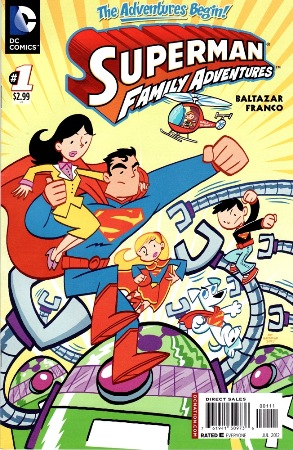
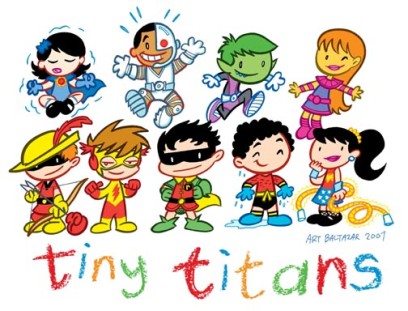
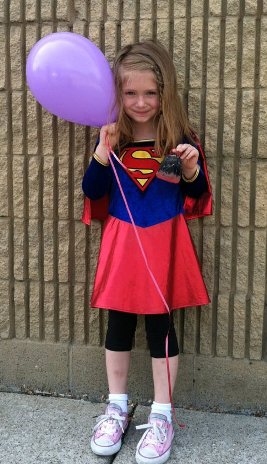
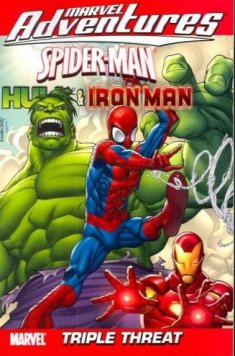
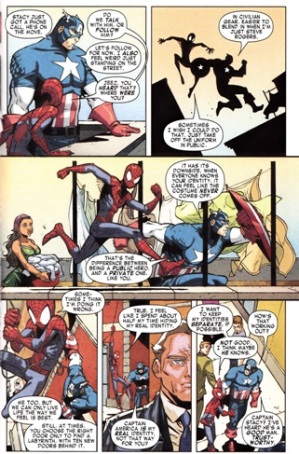
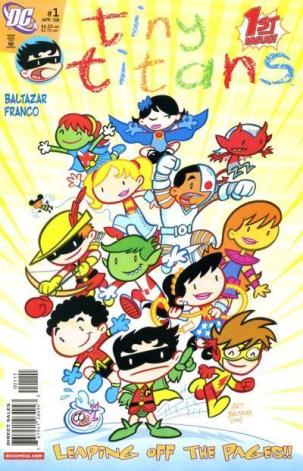
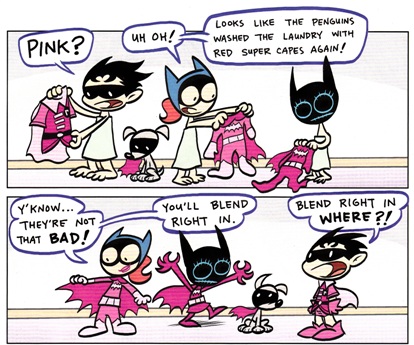
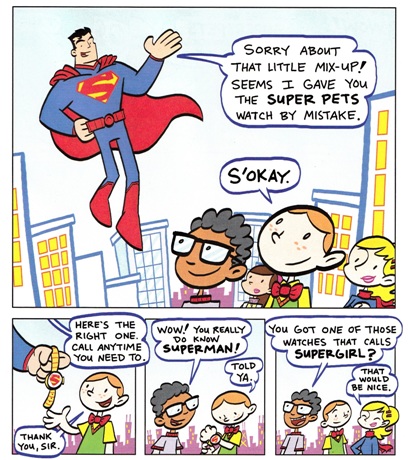
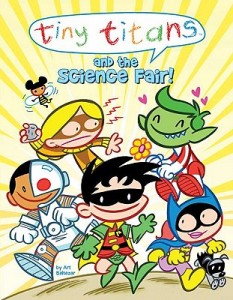
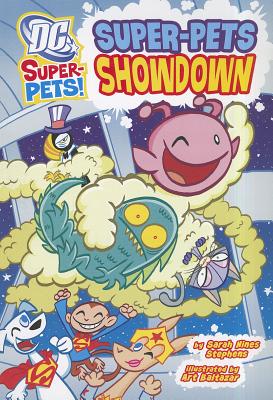
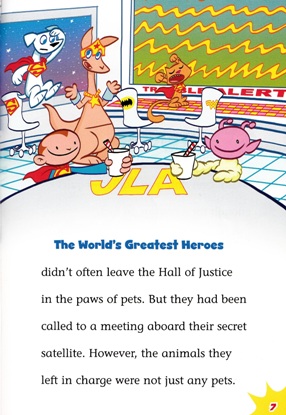
{ 1 comment… read it below or add one }
I love Tiny Titans and Superman Family Adventures, but they do have dosings of sexism in them.
You must log in to post a comment.